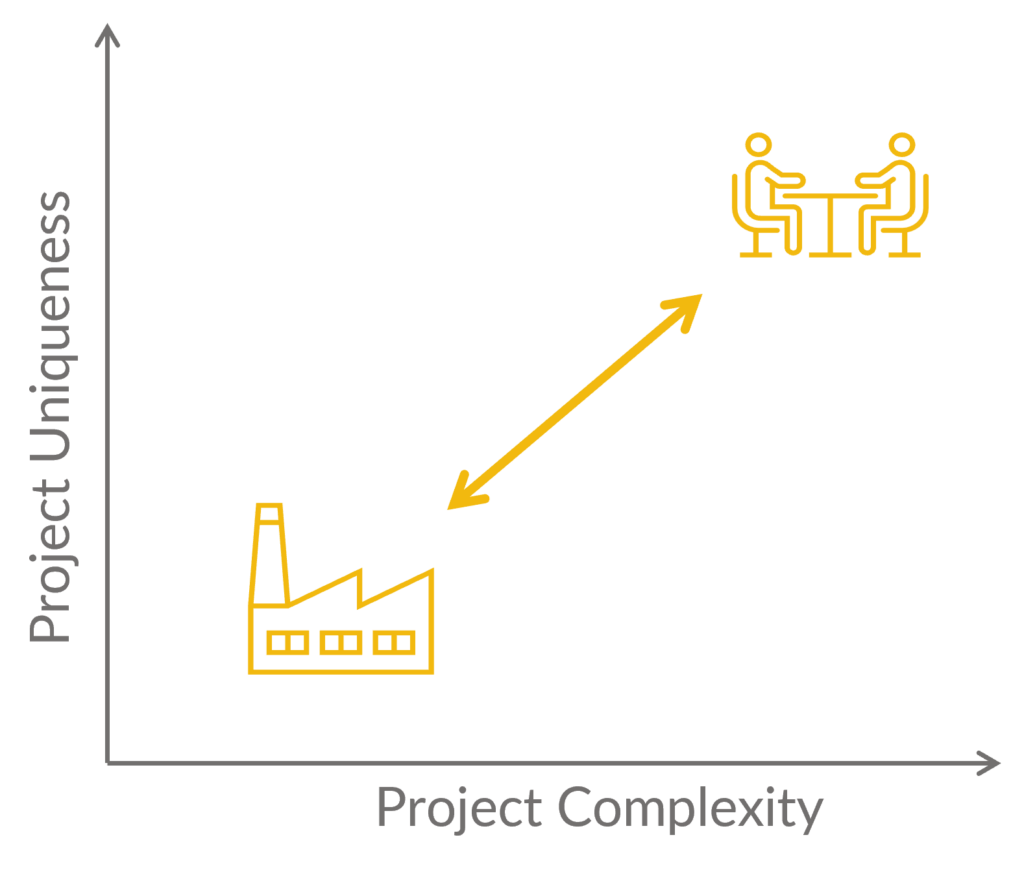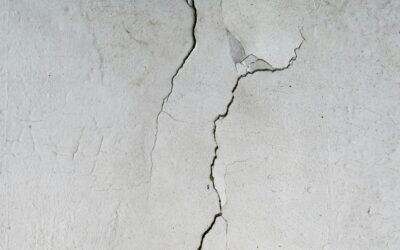
This post originally appeared in our newsletter. Sign up to get our latest research, insights, tools, and resources delivered straight to your inbox twice a month.
Take our Factory-Consultancy Evaluation & Learn Where Your Agency Lands
Complexity 2.0: The Factory–Consultancy Continuum (Refined)
Digital agencies exist along a continuum of complexity and uniqueness.
At one end are Factory-style shops, and at the other, Consultancy-style shops.
Factory-style shops offer simple, repeatable solutions while Consultancy-style shops tackle highly complex and unique challenges.
Where your agency lands affects almost everything: your service mix, pricing strategies, staffing models, client acquisition approach, and even your exit potential. This is a key reason why some strategies and tactics work beautifully at one shop but fall apart at another.
Matching your strategies and tactics to where you land on the Factory-Consultancy continuum reduces friction and makes growth easier.
Defining the Spectrum
What do you solve for your clients?
Specifically: How unique and complex are the projects you deliver?
At the factory end, shops solve simple, repeatable challenges across clients. Things like social media posts, WYSIWYG brochure websites, and PPC media designs.
Firms at this end are the factories.
Although the term can have a negative connotation, we don’t mean it disparagingly. Factories can become significant businesses if built correctly. The key is embracing it.
Attributes of Factory-style Agencies:
- Pre-defined project/service scope
- Simple workflow diagrams
- Standardized pricing
- Low project customization
- Lower talent costs
- Easier staffing
- More commoditized service mix
- Short, low-touch sales cycles
- A large number of clients (low concentration)
- Smoother, more predictable revenue
- Focus on margins
- Easier owner exits
At the other end of the spectrum, the challenges shops solve are as complex as they get. They often go beyond the purview of “digital.” Here, shops solve things like digitizing customer relationships, designing and implementing AI solutions, and implementing IoT rollouts across global networks.
These are the Consultancies.
Attributes of Consultancy-style Agencies:
- Sizable “discovery” phases
- Complex workflow diagrams
- Fluid pricing
- Highly customized projects
- High talent costs
- Difficult staffing
- More cutting-edge service mix
- Long and high-touch sales cycles
- Fewer clients (high concentration)
- Choppy, less predictable revenue
- Focus on thought leadership
- Complicated owner exits
The Full Matrix

| Unique | Hammers | Consultancies |
| Generic | Factories | Products |
| Simple | Complex |
Quadrant Definitions:
Low uniqueness, low complexity: Factories. Standardized, simple offerings at scale.
High uniqueness, high complexity: Consultancies. Custom, strategic, complex work requiring high expertise and strong client intimacy.
The other areas:
High uniqueness, low complexity: Hammers. Here, shops have a hammer, and everything they see is a nail. E.g. A social media shop that tries to solve every challenge with more social media. They come across as tone-deaf to the client’s actual issues.
Low uniqueness, high complexity: Products. Complex builds that should be SaaS/products instead of custom agency services. If a project is complex (by necessity, not just for fun), it’s probably because the challenge it’s solving has a lot of unique qualifiers. Complex projects that solve common challenges tend to fall in the “products” domain. An agency typically isn’t the right structure to scale products.
The Middle Ground and Pitfalls
As I mentioned in the opening, every shop will fall somewhere along this line. While that’s true, most tend to fall more towards the middle of the line versus either of the poles.
Living in the middle is challenging because in order to optimize any one strategy component or process, you are often forced to make a tradeoff.
Take project scoping as an example.
Some agencies charge for scoping, while others treat it as a cost of winning new business. Whether you should charge depends entirely on the complexity of your work.
If you’re selling factory-style services,like standardized brochure websites for SMBs, charging for scoping is almost impossible to justify.
The projects are simple.
The client knows they’re simple.
There are even competitors offering flat-fee, one-week turnarounds.
Charging for discovery only makes sense when projects are complex and unique enough to warrant it.
Sales hiring follows the same logic.
What kind of salesperson should you bring in?
If you’re selling simple, repeatable services like brochure websites to SMBs, you do not want a salesperson who built their career closing large, complex enterprise deals.
The skills don’t transfer.
The sales cycle, buyer psychology, and pricing power are totally different.
I’d rather hire someone with door-to-door experience here than an ex-Oracle rep.
Hopefully, these examples help illustrate that one isn’t necessarily better than another, what’s important is that the strategies and tactics match your type of agency. If the agency type is a mixture of both factory and consultancy style elements, then matching becomes difficult.
Strategic Drift
Even agencies that start with strong alignment aren’t immune to strategic drift.
Strategic drift happens unintentionally.
- A few client exceptions.
- A new service line that doesn’t quite fit.
- A shift in who’s leading key accounts.
Over time, these small moves pull the agency away from its intended position along the Factory-Consultancy Continuum, often without leadership making an intentional decision to do so.
The result is internal friction, confused positioning, operational inefficiency, and often, leadership frustration about “why things feel harder.”
Managing drift:
Build an annual or semi-annual model audit into your leadership planning cycle.
Ask: Does the majority of our work today match the model we are designed for?
If not, decide: Do we realign back to the model, or intentionally evolve the model?
Be Intentional
You can cut a TON of friction in your shop by aligning your strategy and tactics with where you’d like your agency to live along this spectrum. The caveat is that you need to be comfortable building that type of business.
Most of the owners I’ve met got there because they’re awesome at doing whatever it is their shop does.
They love their craft.
These owners tend to lean towards building consultancies, primarily because they can still be involved in the craft. Owners who aren’t interested in doing the day-to-day tend to favor factory-style structures.
A few months ago, I was chatting with someone who was frustrated with how much time his sales staff was spending nurturing accounts. Part of his shop was set up to run like a factory, but the sales and marketing functions (along with pricing) were set up more like a consultancy.
He thought good salespeople were just impossible to find.
They aren’t, but they do need to be in a system that sets them up for success. Adopting a lower-touch, lower-price model and standardizing the offerings would help align the revgen team with the rest of the business and remove much of this frustration.
The same kinds of challenges happen to consultancies that try to run segments like factories. I see this a lot with retainers. Consultancy owners see the steady revenue and think the grass is WAY greener over there.
It isn’t. It’s just a different shade.
Embracing either the factory or consultancy style will make many decisions clearer. From service mix, to pricing strategies, to staffing and operations. Just about every decision gets easier the closer you are to the poles.
The point of all this is to be yourself. Build your company in a way that matches where you’re comfortable. Then, drop preconceived ideas about factories being lowbrow, or consultancies being prestigious. There are plenty of good (and horrible) examples of both. Finally, be aware that this kind of shift doesn’t come without its own risks:
Factories must relentlessly fight commoditization and price erosion, while Consultancies need to navigate client concentration risk and uneven cash flow.
Both models have successful and failed examples. Neither is “better.” The right choice depends on your risk appetite, leadership style, and long-term ambition, and your model should evolve over time.




